check engine TOYOTA GR YARIS 2023 Owner's Manual
[x] Cancel search | Manufacturer: TOYOTA, Model Year: 2023, Model line: GR YARIS, Model: TOYOTA GR YARIS 2023Pages: 470, PDF Size: 113.17 MB
Page 247 of 470
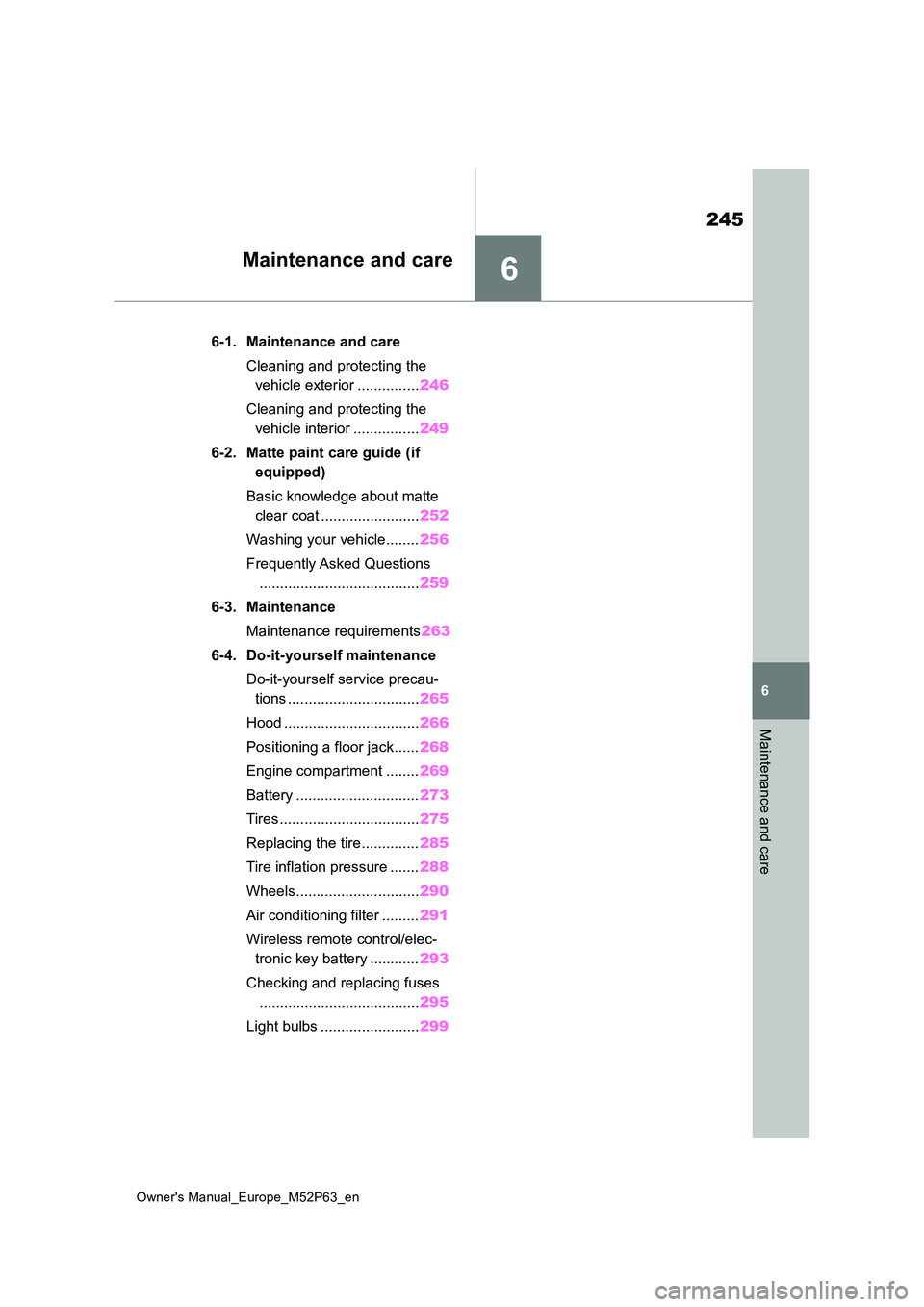
6
245
Owner's Manual_Europe_M52P63_en
6
Maintenance and care
Maintenance and care
6-1. Maintenance and care
Cleaning and protecting the
vehicle exterior ............... 246
Cleaning and protecting the
vehicle interior ................ 249
6-2. Matte paint care guide (if
equipped)
Basic knowledge about matte
clear coat ........................ 252
Washing your vehicle........ 256
Frequently Asked Questions
....................................... 259
6-3. Maintenance
Maintenance requirements 263
6-4. Do-it-yourself maintenance
Do-it-yourself service precau-
tions ................................ 265
Hood ................................. 266
Positioning a floor jack...... 268
Engine compartment ........ 269
Battery .............................. 273
Tires .................................. 275
Replacing the tire.............. 285
Tire inflation pressure ....... 288
Wheels.............................. 290
Air conditioning filter ......... 291
Wireless remote control/elec-
tronic key battery ............ 293
Checking and replacing fuses
....................................... 295
Light bulbs ........................ 299
Page 266 of 470

264
Owner's Manual_Europe_M52P63_en
6-3. Maintenance
request that a record of maintenance
be kept.
■Does your vehicle need repairs?
Be on the alert for changes in perfor- mance and sounds, and visual tip-offs
that indicate service is needed. Some important clues are:
●Engine misses (misfire), stumbling or pinging
●Appreciable loss of power
●Strange engine noises
●A fluid leak under the vehicle (How-ever, water dripping from the air con-
ditioning system after use is normal.)
●Change in exhaust sound (This may
indicate a dangerous carbon monox- ide leak. Drive with the windows open and have the exhaust system checked
immediately.)
●Flat-looking tires, excessive tire
squeal when cornering, uneven tire wear
●Vehicle pulls to one side when driven straight on a level road
●Strange noises related to suspension movement
●Loss of brake effectiveness, spongy feeling brake pedal or clutch pedal (vehicles with a manual transmission),
pedal almost touches the floor, vehicle pulls to one side when braking
●Engine coolant temperature continu-ally higher than normal ( P.81, 84)
If you notice any of these clues, take
your vehicle to any authorized Toyota
retailer or Toyota authorized repairer, or
any reliable repairer as soon as possi-
ble. Your vehicle may need adjustment
or repair.
Page 271 of 470
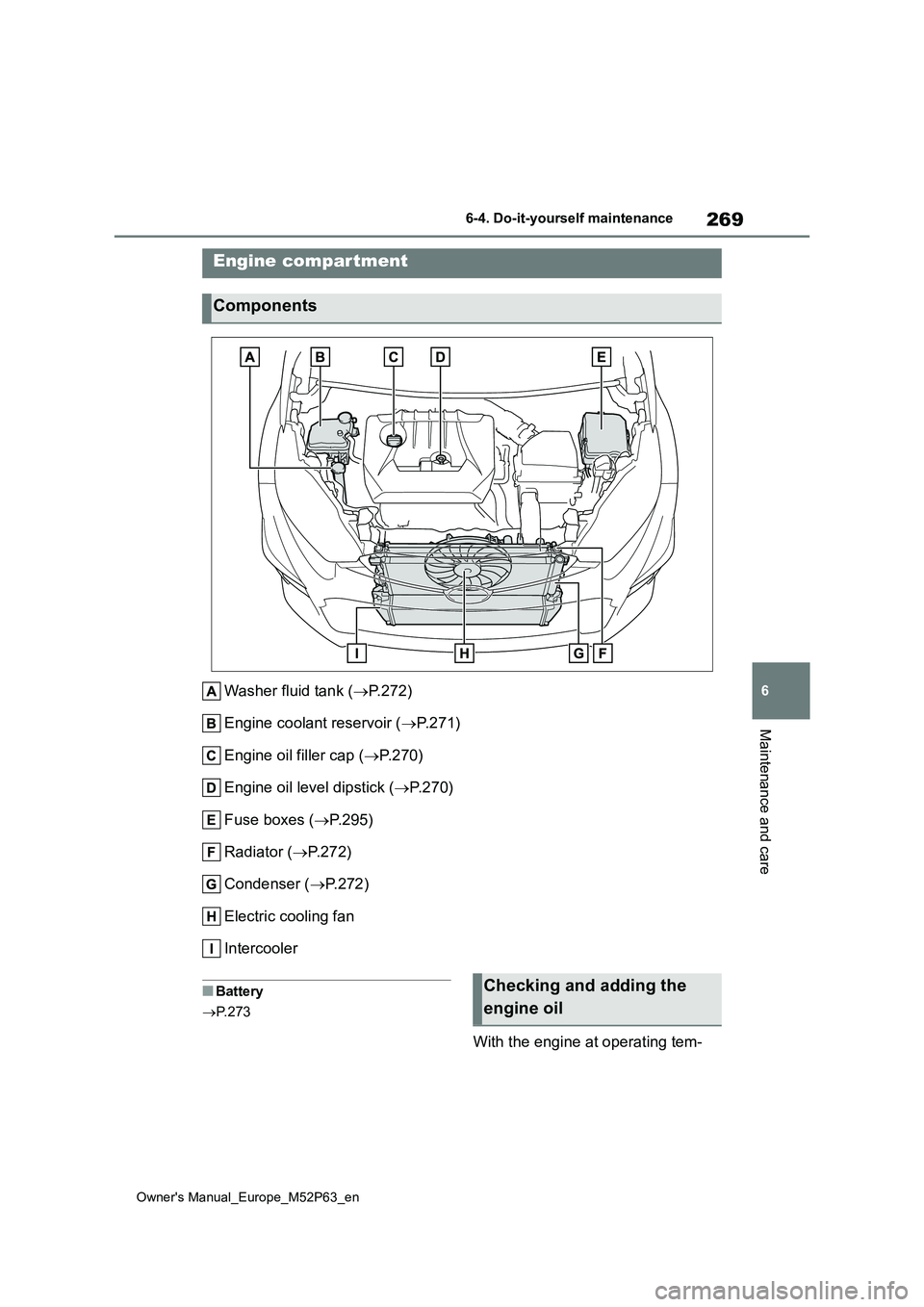
269
6
Owner's Manual_Europe_M52P63_en
6-4. Do-it-yourself maintenance
Maintenance and care
Washer fluid tank (P.272)
Engine coolant reservoir ( P. 2 7 1 )
Engine oil filler cap ( P.270)
Engine oil level dipstick ( P.270)
Fuse boxes ( P.295)
Radiator ( P.272)
Condenser ( P.272)
Electric cooling fan
Intercooler
■Battery
P. 2 7 3
With the engine at operating tem-
Engine compartment
Components
Checking and adding the
engine oil
Page 272 of 470
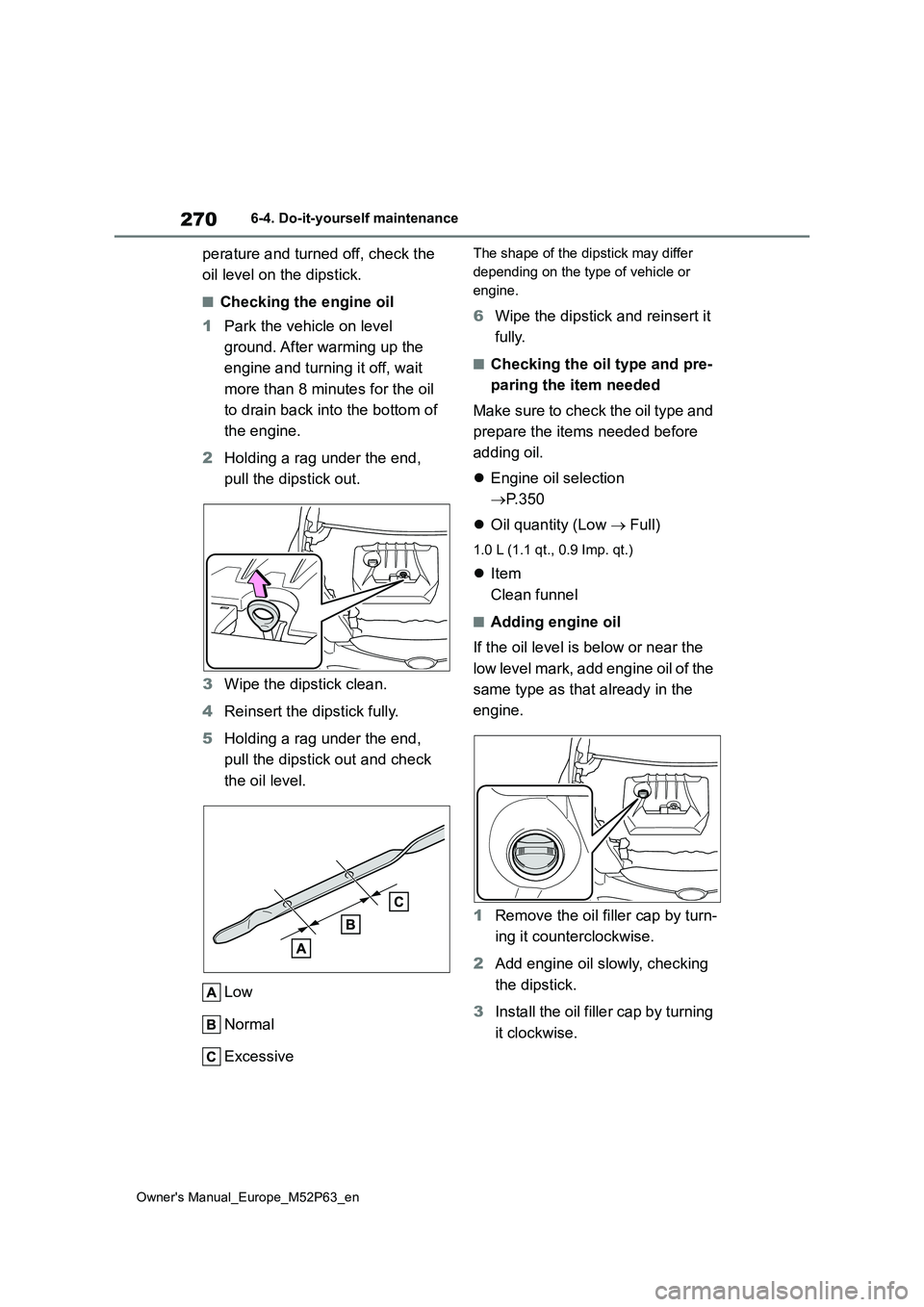
270
Owner's Manual_Europe_M52P63_en
6-4. Do-it-yourself maintenance
perature and turned off, check the
oil level on the dipstick.
■Checking the engine oil
1 Park the vehicle on level
ground. After warming up the
engine and turning it off, wait
more than 8 minutes for the oil
to drain back into the bottom of
the engine.
2 Holding a rag under the end,
pull the dipstick out.
3 Wipe the dipstick clean.
4 Reinsert the dipstick fully.
5 Holding a rag under the end,
pull the dipstick out and check
the oil level.
Low
Normal
Excessive
The shape of the dipstick may differ
depending on the type of vehicle or
engine.
6 Wipe the dipstick and reinsert it
fully.
■Checking the oil type and pre-
paring the item needed
Make sure to check the oil type and
prepare the items needed before
adding oil.
Engine oil selection
P.350
Oil quantity (Low Full)
1.0 L (1.1 qt., 0.9 Imp. qt.)
Item
Clean funnel
■Adding engine oil
If the oil level is below or near the
low level mark, add engine oil of the
same type as that already in the
engine.
1 Remove the oil filler cap by turn-
ing it counterclockwise.
2 Add engine oil slowly, checking
the dipstick.
3 Install the oil filler cap by turning
it clockwise.
Page 273 of 470
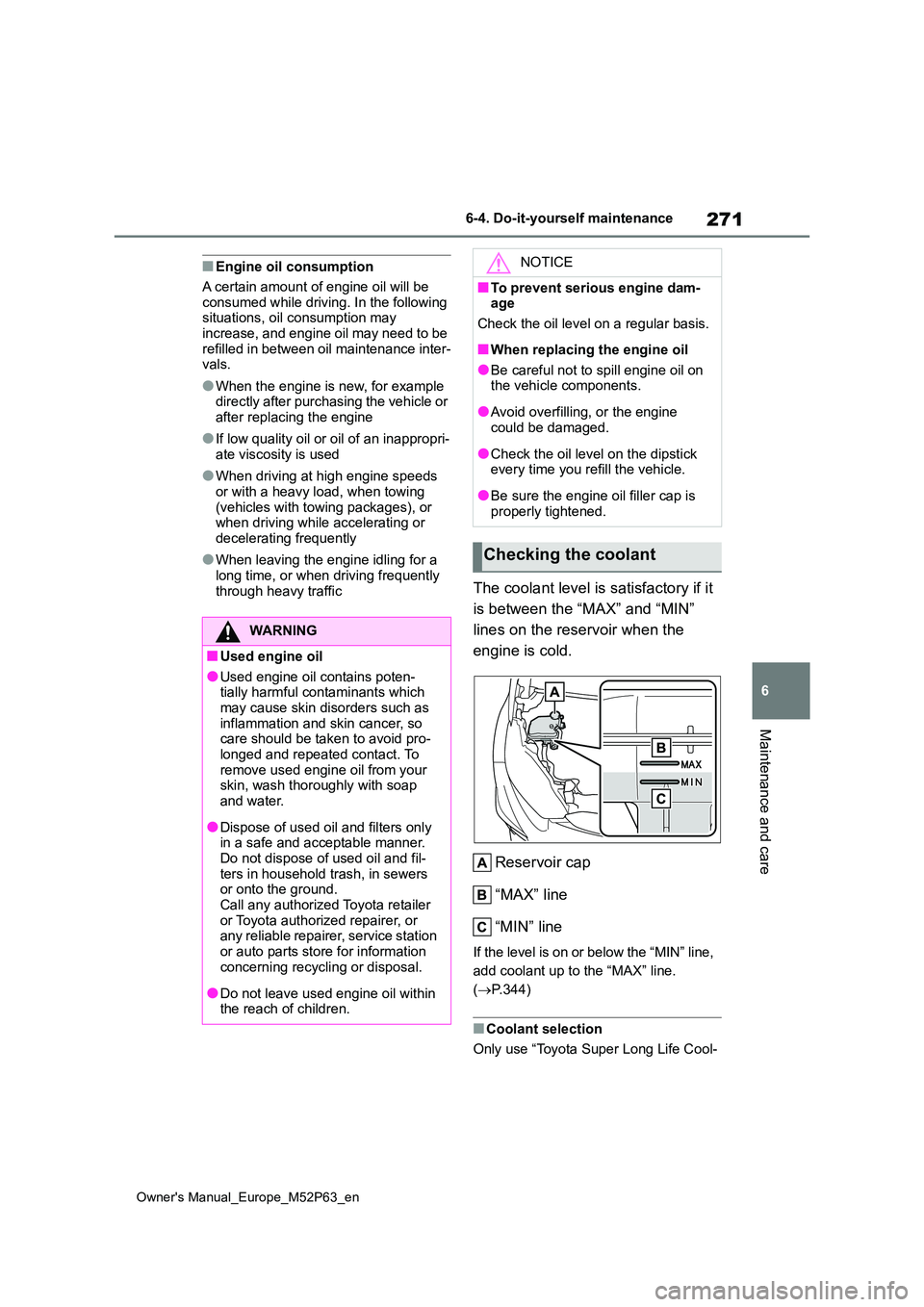
271
6
Owner's Manual_Europe_M52P63_en
6-4. Do-it-yourself maintenance
Maintenance and care
■Engine oil consumption
A certain amount of engine oil will be
consumed while driving. In the following situations, oil consumption may increase, and engine oil may need to be
refilled in between oil maintenance inter- vals.
●When the engine is new, for example directly after purchasing the vehicle or after replacing the engine
●If low quality oil or oil of an inappropri-ate viscosity is used
●When driving at high engine speeds or with a heavy load, when towing
(vehicles with towing packages), or when driving while accelerating or decelerating frequently
●When leaving the engine idling for a long time, or when driving frequently
through heavy trafficThe coolant level is satisfactory if it
is between the “MAX” and “MIN”
lines on the reservoir when the
engine is cold.
Reservoir cap
“MAX” line
“MIN” line
If the level is on or below the “MIN” line,
add coolant up to the “MAX” line.
( P.344)
■Coolant selection
Only use “Toyota Super Long Life Cool-
WARNING
■Used engine oil
●Used engine oil contains poten- tially harmful contaminants which may cause skin disorders such as
inflammation and skin cancer, so care should be taken to avoid pro-longed and repeated contact. To
remove used engine oil from your skin, wash thoroughly with soap and water.
●Dispose of used oil and filters only in a safe and acceptable manner.
Do not dispose of used oil and fil- ters in household trash, in sewers or onto the ground.
Call any authorized Toyota retailer or Toyota authorized repairer, or any reliable repairer, service station
or auto parts store for information concerning recycling or disposal.
●Do not leave used engine oil within the reach of children.
NOTICE
■To prevent serious engine dam-age
Check the oil level on a regular basis.
■When replacing the engine oil
●Be careful not to spill engine oil on the vehicle components.
●Avoid overfilling, or the engine could be damaged.
●Check the oil level on the dipstick every time you refill the vehicle.
●Be sure the engine oil filler cap is properly tightened.
Checking the coolant
Page 274 of 470
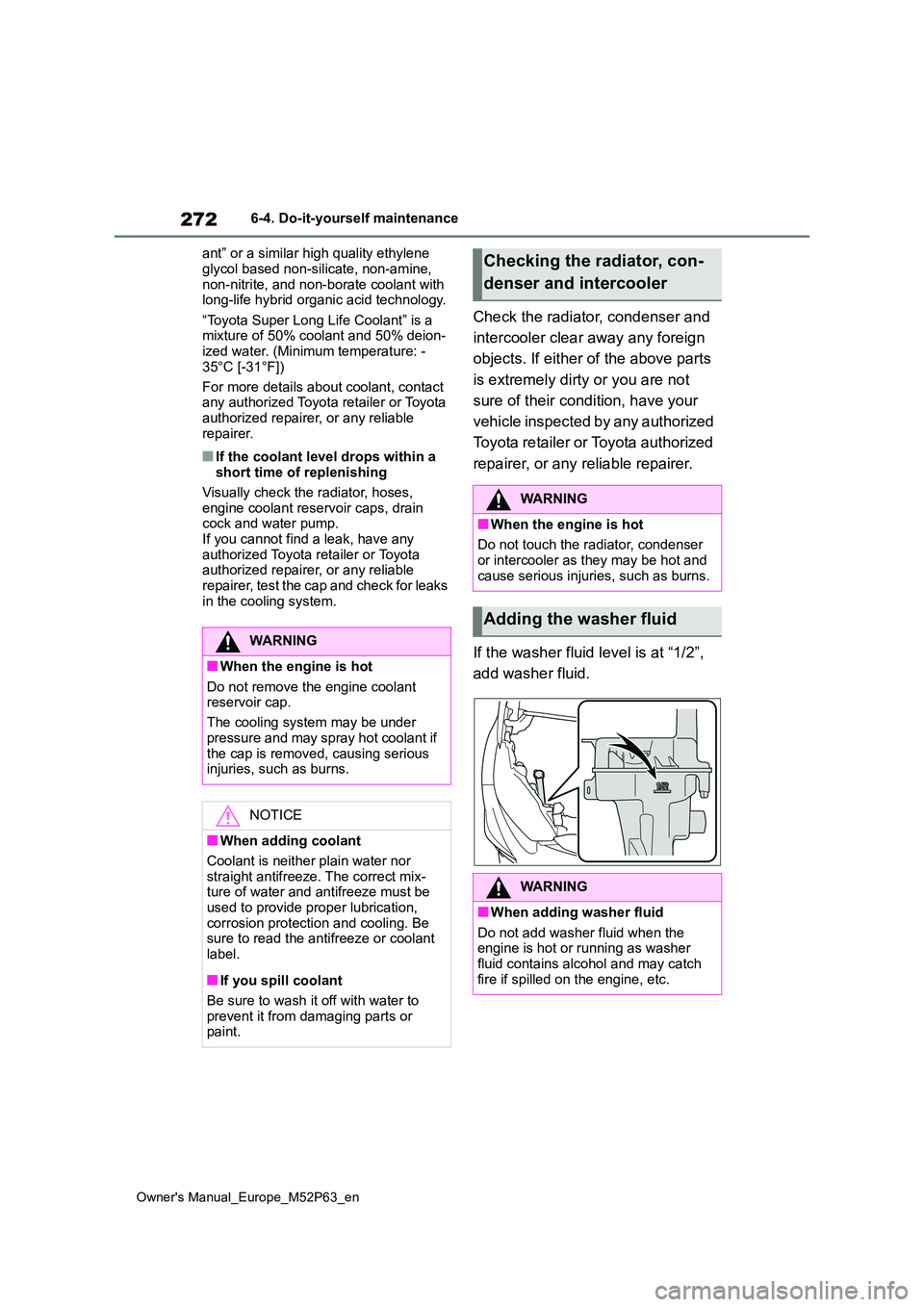
272
Owner's Manual_Europe_M52P63_en
6-4. Do-it-yourself maintenance
ant” or a similar high quality ethylene
glycol based non-silicate, non-amine, non-nitrite, and non-borate coolant with long-life hybrid organic acid technology.
“Toyota Super Long Life Coolant” is a mixture of 50% coolant and 50% deion-ized water. (Minimum temperature: -
35°C [-31°F])
For more details about coolant, contact any authorized Toyota retailer or Toyota
authorized repairer, or any reliable repairer.
■If the coolant level drops within a short time of replenishing
Visually check the radiator, hoses, engine coolant reservoir caps, drain cock and water pump.
If you cannot find a leak, have any authorized Toyota retailer or Toyota authorized repairer, or any reliable
repairer, test the cap and check for leaks in the cooling system.
Check the radiator, condenser and
intercooler clear away any foreign
objects. If either of the above parts
is extremely dirty or you are not
sure of their condition, have your
vehicle inspected by any authorized
Toyota retailer or Toyota authorized
repairer, or any reliable repairer.
If the washer fluid level is at “1/2”,
add washer fluid.
WARNING
■When the engine is hot
Do not remove the engine coolant reservoir cap.
The cooling system may be under
pressure and may spray hot coolant if the cap is removed, causing serious injuries, such as burns.
NOTICE
■When adding coolant
Coolant is neither plain water nor straight antifreeze. The correct mix-ture of water and antifreeze must be
used to provide proper lubrication, corrosion protection and cooling. Be sure to read the antifreeze or coolant
label.
■If you spill coolant
Be sure to wash it off with water to prevent it from damaging parts or paint.
Checking the radiator, con-
denser and intercooler
WARNING
■When the engine is hot
Do not touch the radiator, condenser
or intercooler as they may be hot and cause serious injuries, such as burns.
Adding the washer fluid
WARNING
■When adding washer fluid
Do not add washer fluid when the engine is hot or running as washer fluid contains alcohol and may catch
fire if spilled on the engine, etc.
Page 277 of 470
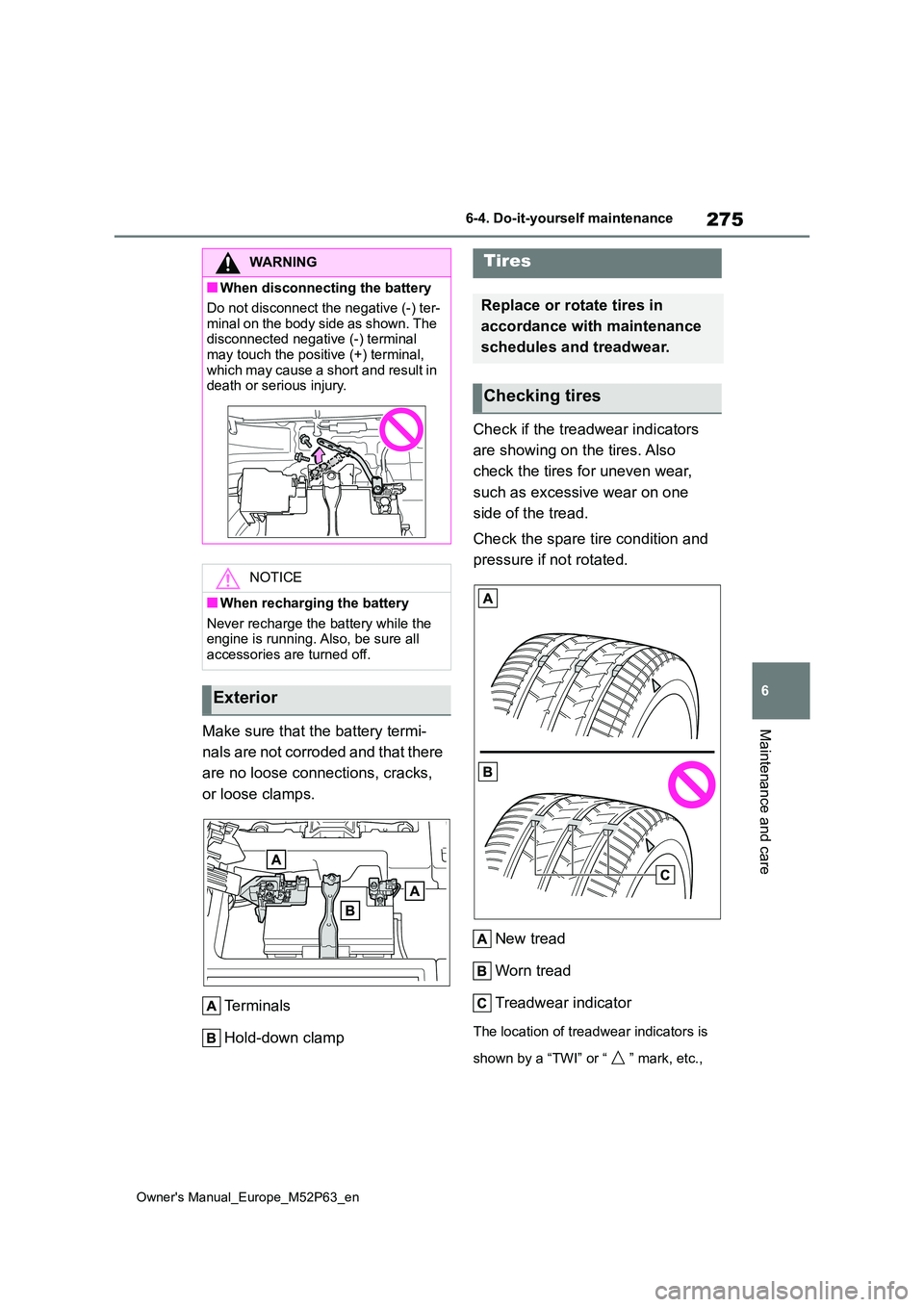
275
6
Owner's Manual_Europe_M52P63_en
6-4. Do-it-yourself maintenance
Maintenance and careMake sure that the battery termi-
nals are not corroded and that there
are no loose connections, cracks,
or loose clamps.
Terminals
Hold-down clamp
Check if the treadwear indicators
are showing on the tires. Also
check the tires for uneven wear,
such as excessive wear on one
side of the tread.
Check the spare tire condition and
pressure if not rotated.
New tread
Worn tread
Treadwear indicator
The location of treadwear indicators is
shown by a “TWI” or “ ” mark, etc.,
WARNING
■When disconnecting the battery
Do not disconnect the negative (-) ter-
minal on the body side as shown. The disconnected negative (-) terminal may touch the positive (+) terminal,
which may cause a short and result in death or serious injury.
NOTICE
■When recharging the battery
Never recharge the battery while the engine is running. Also, be sure all accessories are turned off.
Exterior
Tires
Replace or rotate tires in
accordance with maintenance
schedules and treadwear.
Checking tires
Page 280 of 470
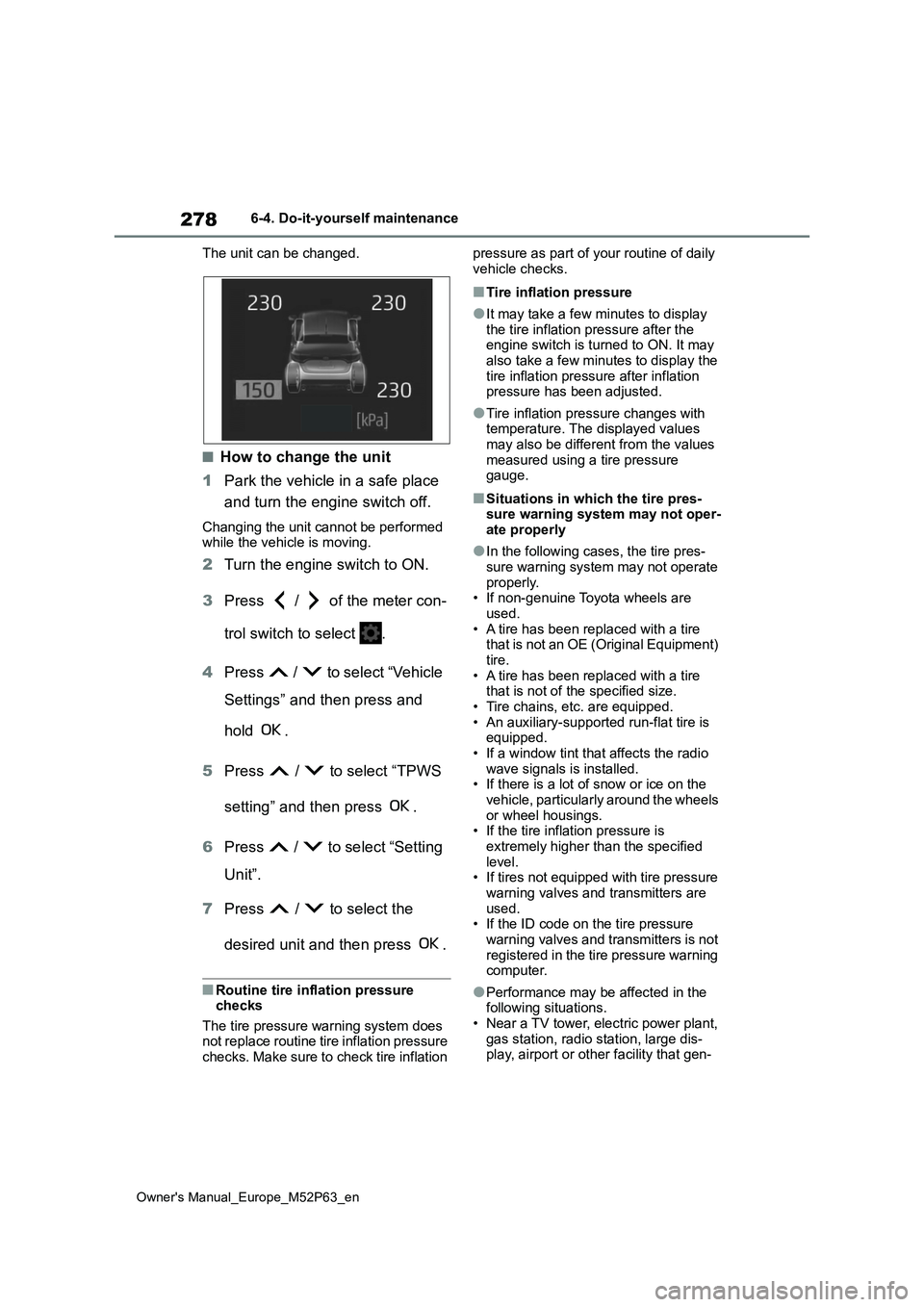
278
Owner's Manual_Europe_M52P63_en
6-4. Do-it-yourself maintenance
The unit can be changed.
■How to change the unit
1 Park the vehicle in a safe place
and turn the engine switch off.
Changing the unit cannot be performed while the vehicle is moving.
2 Turn the engine switch to ON.
3 Press / of the meter con-
trol switch to select .
4 Press / to select “Vehicle
Settings” and then press and
hold .
5 Press / to select “TPWS
setting” and then press .
6 Press / to select “Setting
Unit”.
7 Press / to select the
desired unit and then press .
■Routine tire inflation pressure checks
The tire pressure warning system does not replace routine tire inflation pressure checks. Make sure to check tire inflation
pressure as part of your routine of daily
vehicle checks.
■Tire inflation pressure
●It may take a few minutes to display
the tire inflation pressure after the engine switch is turned to ON. It may also take a few minutes to display the
tire inflation pressure after inflation pressure has been adjusted.
●Tire inflation pressure changes with temperature. The displayed values may also be different from the values
measured using a tire pressure gauge.
■Situations in which the tire pres-sure warning system may not oper-
ate properly
●In the following cases, the tire pres-
sure warning system may not operate properly.• If non-genuine Toyota wheels are
used. • A tire has been replaced with a tire that is not an OE (Original Equipment)
tire. • A tire has been replaced with a tire that is not of the specified size.
• Tire chains, etc. are equipped. • An auxiliary-supported run-flat tire is equipped.
• If a window tint that affects the radio wave signals is installed.• If there is a lot of snow or ice on the
vehicle, particularly around the wheels or wheel housings.• If the tire inflation pressure is
extremely higher than the specified level.• If tires not equipped with tire pressure
warning valves and transmitters are used.• If the ID code on the tire pressure
warning valves and transmitters is not registered in the tire pressure warning computer.
●Performance may be affected in the following situations.
• Near a TV tower, electric power plant, gas station, radio station, large dis-play, airport or other facility that gen-
Page 287 of 470
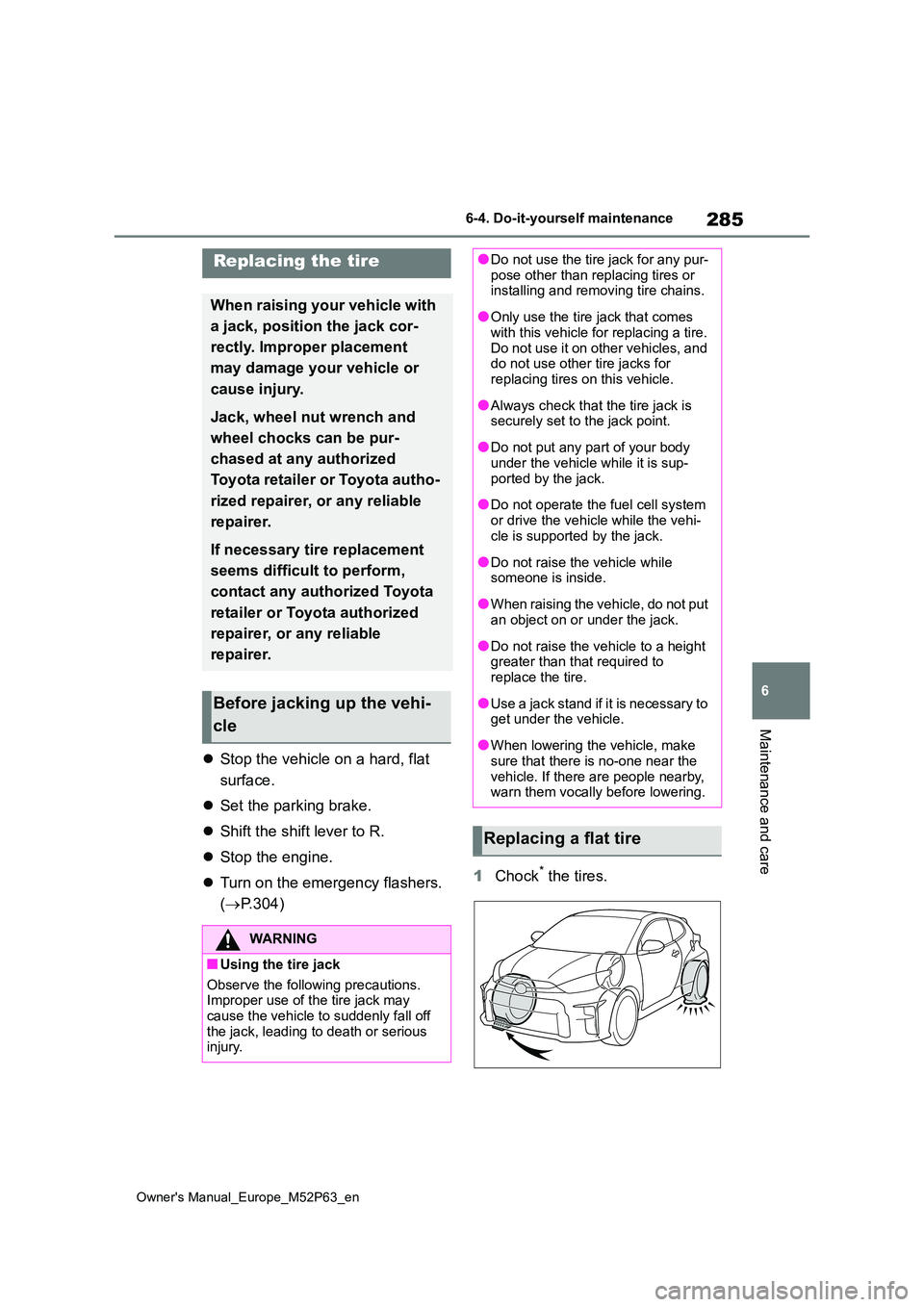
285
6
Owner's Manual_Europe_M52P63_en
6-4. Do-it-yourself maintenance
Maintenance and care
Stop the vehicle on a hard, flat
surface.
Set the parking brake.
Shift the shift lever to R.
Stop the engine.
Turn on the emergency flashers.
( P.304)
1 Chock* the tires.
Replacing the tire
When raising your vehicle with
a jack, position the jack cor-
rectly. Improper placement
may damage your vehicle or
cause injury.
Jack, wheel nut wrench and
wheel chocks can be pur-
chased at any authorized
Toyota retailer or Toyota autho-
rized repairer, or any reliable
repairer.
If necessary tire replacement
seems difficult to perform,
contact any authorized Toyota
retailer or Toyota authorized
repairer, or any reliable
repairer.
Before jacking up the vehi-
cle
WARNING
■Using the tire jack
Observe the following precautions. Improper use of the tire jack may cause the vehicle to suddenly fall off
the jack, leading to death or serious injury.
●Do not use the tire jack for any pur-pose other than replacing tires or installing and removing tire chains.
●Only use the tire jack that comes with this vehicle for replacing a tire.
Do not use it on other vehicles, and do not use other tire jacks for replacing tires on this vehicle.
●Always check that the tire jack is securely set to the jack point.
●Do not put any part of your body under the vehicle while it is sup-
ported by the jack.
●Do not operate the fuel cell system
or drive the vehicle while the vehi- cle is supported by the jack.
●Do not raise the vehicle while someone is inside.
●When raising the vehicle, do not put an object on or under the jack.
●Do not raise the vehicle to a height greater than that required to replace the tire.
●Use a jack stand if it is necessary to get under the vehicle.
●When lowering the vehicle, make sure that there is no-one near the
vehicle. If there are people nearby, warn them vocally before lowering.
Replacing a flat tire
Page 293 of 470
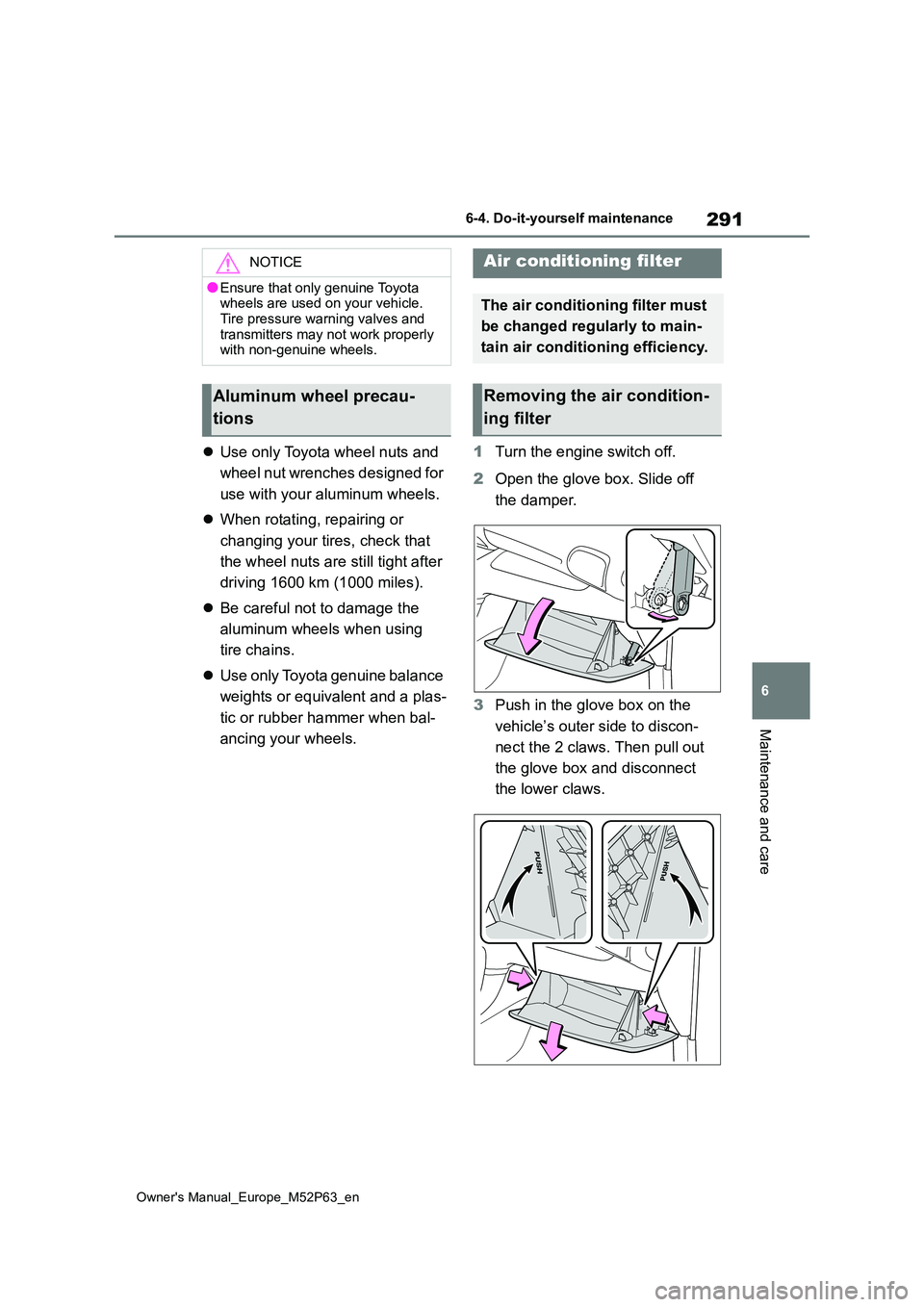
291
6
Owner's Manual_Europe_M52P63_en
6-4. Do-it-yourself maintenance
Maintenance and care
Use only Toyota wheel nuts and
wheel nut wrenches designed for
use with your aluminum wheels.
When rotating, repairing or
changing your tires, check that
the wheel nuts are still tight after
driving 1600 km (1000 miles).
Be careful not to damage the
aluminum wheels when using
tire chains.
Use only Toyota genuine balance
weights or equivalent and a plas-
tic or rubber hammer when bal-
ancing your wheels.
1 Turn the engine switch off.
2 Open the glove box. Slide off
the damper.
3 Push in the glove box on the
vehicle’s outer side to discon-
nect the 2 claws. Then pull out
the glove box and disconnect
the lower claws.
NOTICE
●Ensure that only genuine Toyota wheels are used on your vehicle.
Tire pressure warning valves and transmitters may not work properly with non-genuine wheels.
Aluminum wheel precau-
tions
Air conditioning filter
The air conditioning filter must
be changed regularly to main-
tain air conditioning efficiency.
Removing the air condition-
ing filter